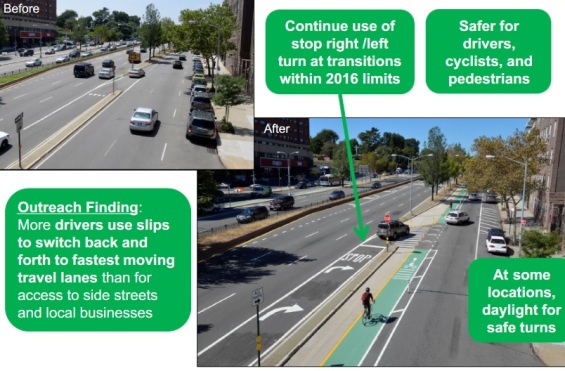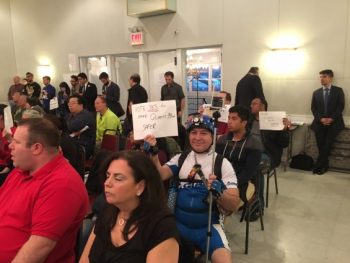
July 26, 2016 By Michael Florio
The Department of Transportation started work Monday on its controversial plan to add bicycle lanes and safety features to Queens Blvd between 74th Street and Eliot Ave.
The DOT expects the work on the 1.2 mile stretch to end by early fall.
The revamp is the second phase of the DOT’s plan to reconfigure Queens Boulevard. Phase 1 went through Woodside and was completed last summer. Phase 3 is expected to go from Rego Park to Forest Hills and is slated to be done in 2017.
This overhaul, which cuts through Elmhurst, involves a number of safety features, such as the installation of protected bicycles lanes along the service road medians; the redesign of slip lanes between mainline and service roads; and improved crosswalks.
This short piece of roadway between 74th Street and Eliot Avenue has a history of being hazardous. The DOT presented statistics during the design phase that showed that from 2010 to 2014, there were 777 total injuries and five fatalities.
While the DOT’s redesign plan overall was well received, the bicycle lane component got a very mixed reception.
Community Board 4 approved the plan except for the bicycle lanes by a vote of 31-1, with 2 abstentions at its May meeting.
“I don’t think Queens Boulevard is necessarily the place for a bike lane,” said CB4 Chairman Lou Walker at the time of the vote. “There are other streets where bikes would be a lot safer and in a lot less traffic.”
It’s standard practice for the DOT to adhere to a decision made by a community board.
However, the day after CB4’s vote, Mayor Bill de Blasio overruled the board and announced that the bicycle lanes would be built.

CB4 May meeting
“I respect those who disagree with us, but in the end, the safety of our neighbors and our children is the most fundamental responsibility we have in this work,” de Blasio said in a statement at the time.
His decision caused mixed reactions by local officials. Queens Borough President Melinda Katz strongly disagreed with it on the grounds that it undermined the community.
“Instead of approaching bike lanes in a vacuum and in piece-meal, segmented fashion, the plan should be postponed for now until the agency can produce a truly community-driven, community-generated, borough-wide plan for the future of bike lanes not only along Queens Boulevard but throughout the borough,” Katz said in a statement at the time.
However, Councilman Daniel Dromm, who represents this portion of Queens Blvd, agreed with the mayor.
“We can’t risking having another death on Queens Boulevard,” Dromm said. “Bike lanes are an essential part of this safety plan,” he said in May. “The Mayor was right in moving forward on this plan.”
Queens Blvd 74th Eliot Ave Mar2016 by Queens Post on Scribd






